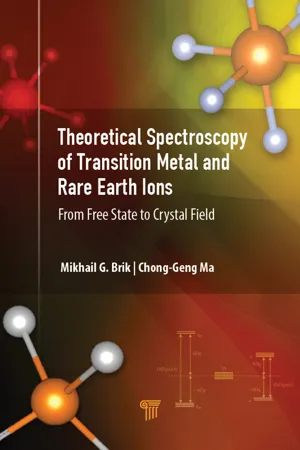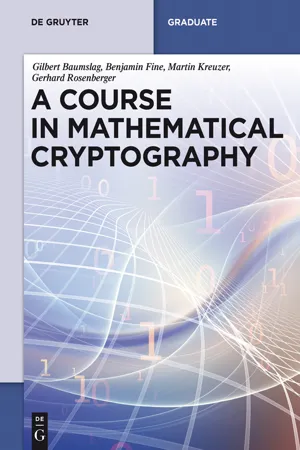Mathematics
Group Theory Terminology
Group theory terminology refers to the language used to describe the properties and operations of groups, which are mathematical structures that represent symmetries and transformations. Key terms include group, subgroup, isomorphism, homomorphism, and automorphism, among others. These terms are used to describe the relationships between groups and their elements.
Written by Perlego with AI-assistance
Related key terms
Related key terms
1 of 4
Related key terms
1 of 3
5 Key excerpts on "Group Theory Terminology"
- eBook - ePub
- Bijan Davvaz(Author)
- 2012(Publication Date)
- WSPC(Publisher)
Chapter 1A Brief Excursion into Group Theory1.1 IntroductionThe concept of a group is one of the most fundamental in modern mathematics. Group theory can be considered the study of symmetry: the collection of symmetries of some object preserving some of its structure forms a group; in some sense all groups arise this way. Although permutations had been studied earlier, the theory of groups really began with Galois (1811-1832) who demonstrated that polynomials are best understood by examining certain groups of permutations of their roots. Since that time, groups have arisen in almost every branch of mathematics. There are three historical roots of group theory:(1) The theory of algebraic equations; (2) Number theory; (3) Geometry.Euler, Gauss, Lagrange, Abel and Galois were early researchers in the field of group theory. Galois is honored as the first mathematician linking group theory and field theory, with the theory that is now called Galois theory.Permutations were first studied by Lagrange (1770, 1771) on the theory of algebraic equations. Lagrange’s main object was to find out why cubic equations could be solved algebraically. In studying the cubic, for example, Lagrange assumes the roots of a given cubic equation are x′, x″ and x′″. Then, taking 1, w, w2 as the cube roots of unity, he examines the expressionand notes that it takes just two different values under the six permutations of the roots x′, x″, x′″. But, he could not fully develop this insight because he viewed permutations only as rearrangements, and not as bijections that can be composed. Composition of permutations does appear in work of Ruffini and Abbati about 1800; in 1815 Cauchy established the calculus of permutations.Galois found that if r1 , r2 , . . . ,rn are the n roots of an equation, there is always a group of permutations of the r - eBook - ePub
Theoretical Spectroscopy of Transition Metal and Rare Earth Ions
From Free State to Crystal Field
- Mikhail G. Brik, Ma Chong-Geng, Mikhail G. Brik, Ma Chong-Geng(Authors)
- 2019(Publication Date)
- Jenny Stanford Publishing(Publisher)
Chapter 7The Group Theory
7.1 Introduction
The group theory emerged from several branches of mathematics: the numbers theory, geometry, and algebraic equations. The foundations of group theory were developed by L. Euler (1707–1783), C.F. Gauss (1777–1855), J.-L. Lagrange (1736–1813), N. H. Abel (1802–1829), E. Galois (1811–1832), and many other prominent mathematicians. At the first glance, the group theory may seem to be a very abstract part of mathematics, which is very far from the real world. However, the area of applications of group theory is surprisingly and unexpectedly wide. It can be used to describe the symmetry properties of various objects. The group theory is very important for combinatorics (permutations and combinations of elements from different sets) and cryptography. It is even applied in the musical set theory, since music—if we forget for the moment about its esthetic component—may be considered as a certain combination of different permutations of the musical notes (well, not every combination of the musical notes can make a pleasant melody though). In chemistry the group theory facilitates description of various properties of molecules and symmetry properties of molecular orbitals. In physics importance of group theory follows from the fact that the symmetry properties of a considered physical system are related to the laws of conservation of certain physical quantities.In the present book, we shall focus on how the group theory can be used to describe the energy levels and spectra of impurity ions in crystals. We shall see that the group theory is a very beautiful and powerful tool for this purpose. It allows finding the overall pattern of the degenerated energy levels splitting. In addition, the selection rules for the allowed/forbidden transitions between those split energy levels can also be established in a simple way with the help of the group theory. It should be stressed that the group theory itself does not give any methods to calculate numerically the matrix elements of the transition operators, which quite often can be quite complicated. However, using the symmetry properties of the initial and final states and the transition operator, it is possible to find out whether the matrix element of the corresponding transition between these states is zero or not. - Syed Afsar Abbas(Author)
- 2016(Publication Date)
- CRC Press(Publisher)
Chapter 2Group Theory
2.1 Definitions and Examples 2.2 Subgroups and Cyclic Groups 2.3 Cosets and Normal Subgroups 2.4 Factor Group 2.5 Homomorphism and Isomorphism 2.6 Torsion Group and Betti Number 2.7 Appendix B: Matrices 2.8 Solutions of Problems2.1 Definitions and Examples
We have seen how in a particular symmetry, say C 3 , a rotation by2around its symmetry axis leaves the equivalent triangle invariant. Successive rotations byπ 32likewise leave the system invariant. There are only three independent transformations, 1,π 32andπ 34rotations. The next rotation toπ 3brings the shape back to itself, i.e., the identity 1. Thus the transformations here form a closed set. The same holds for a more general6= 2 ππ 3CNandDN.Let us now generalize to such a symmetry as those particular transformations which exhibit the property that two successive transformations of a particular type are equivalent to a single transformation of the same type. Symbolically say first,x = x ′ + aNextx ″ = x ′ + bThenx ″ = x + (a + b ) = x + cSuch transformations exhibiting such a property are denominated a group if, in addition, they follow certain conditions.A group is a set of elements G = {a, b, c , ....} obeying a single law of composition (defined as a • b ) which must satisfy the following constraints:(1) Closure: a , b ∈ G then a • b = c ∈ G(2) Associativity: a, b, c ∈ G and (a • b ) • c = a • (b • c )(3) Identity: These exists i ∈ G such that for a ∈ G i • a = a • i = a(4) Inverse: For every a ∈ G these exists an inverse a −1 ∈ G such that a • a −1 = a −1 • a = i(Note: The symbol • denotes any mathematical composition such as +, −, ×, ÷ and any other mathematical operation as we see below)If in addition a • b = b • a then the group is termed Abelian. If a • b ≠ b • a then the group is called non-Abelian. Note that a group is comprised of two entities; a set G and a binary operation • on G. Thus there are two ingredients involved. When the existence of a group G is asserted, the presence of an associated binary operation is implicitly implied [19- eBook - ePub
- Bhavanari Satyanarayana, T.V. Pradeep Kumar, Shaik Mohiddin Shaw(Authors)
- 2019(Publication Date)
- CRC Press(Publisher)
HAPTER - 12
LEARNING OBJECTIVESAlgebraic Structures(Groups and Rings)♦ to understand the fundamental Concepts of Group Theory♦ to know the concept of Coset♦ to understand the concept: Ring and examplesWe begin our study of algebraic structures by investigating sets associated with single operations that satisfy certain reasonable axioms; that is, we wish to define an operation on a set in a way that will generalize such familiar structures as the integers Z together with the single operations of addition, matrix multiplication. We study the important algebraic object known as group which serve as one of the fundamental building blocks for the abstract algebra. In fact group theory has several applications in every area where symmetry occurs. Applications of groups also can be found in physics, chemistry. Some of exciting applications of group theory have arisen in fields such as particle physics, and binary codes.12.1 Fundamental Concepts in Group Theory
Definition(i) We recollect that for a non empty set G, a binary operation on G is mapping from G × G to G. In general, binary operations are denoted by *, ., o etc.(ii) A non empty set G together with a binary operation * is called a group if the algebraic system (G, *) satisfies the following four axioms:(a) Closure axiom: a, b are elements of G, implies a*b is an element of G.(b) Associative axiom: (a*b)*c = a*(b*c) for all elements a, b, c in G.(c) Identity axiom: There exists an element ‘e’ in G such thata * e = e * a = a for all a ∈ G .(d) Inverse axiom: For any element a in G there corresponds an element b in G such that a*b = e = b*a.Note:The element e of G (given in identity axiom) is called an identity element. The element b (given in the inverse axiom) is called an inverse of a in G.DefinitionLet (G, *) be a group. Then (G, *) is said to be a commutative group (or Abelian group) if it satisfies the commutative property: a*b = b*a for all a, b in G.Example 12.1Take G = {−1, 1}. Then (G, .) is a commutative group w.r.t. the usual multiplication of numbers. - eBook - ePub
- Gilbert Baumslag, Benjamin Fine, Martin Kreuzer, Gerhard Rosenberger(Authors)
- 2015(Publication Date)
- De Gruyter(Publisher)
9 Basic Concepts from Group Theory9.1 Groups and Group Theory
Up to this point we have been using algebraic objects arising from number theory, such as the modular rings n and elliptic curve groups, to do encryption. These objects are all commutative and hence we can call the type of encryption we have already done as commutative cryptography. In an effort to improve upon cryptographic security, non-commutative cryptography was introduced. Non-commutative cryptography is essentially group based cryptography. In group based cryptography, non-abelian groups and their properties are used in encryption and decryption. There are two primary sources for non-abelian groups: linear groups, that is, groups of matrices, and combinatorial group theory. In this chapter we describe the necessary material from group theory in general, and combinatorial group theory in particular, that is essential for non-commutative cryptographic purposes. First we define a group.Definition 9.1.1. A group G is a set with one binary operation which we will denote by either multiplication • or just juxtaposition, such that:(1) The operation is associative, that is, (g 1 g 2 )g 3 = g 1 (g 2 g 3 ) for allg 1 ,g 2 , g 3 e G.(2) There exists an identity for this operation, that is, an element 1 such that 1g = g and g 1 = g for each g e G.(3) Each g e G has an inverse for this operation, that is, for each g there exists a g −1 with the property that gg −1 = 1 and g −1 g = 1.If in addition the operation is commutative, that is g 1 g 2 = g 2 g 1 for all g 1 , g 2 e G, the group G is called an abelian group.The order of a group G , denoted |G |, is the number of elements in the group G . If |G | < to, G is a called a finite group, otherwise it is an infinite group.It follows easily from the definition that the identity is unique and that each element has a unique inverse.Lemma 9.1.2.If G is a group then there is a unique identity. Further ifg e G its inverse is unique. Finally if g 1 , g 2 e Gthen (g^)−1 = g-^g-1
Index pages curate the most relevant extracts from our library of academic textbooks. They’ve been created using an in-house natural language model (NLM), each adding context and meaning to key research topics.
Explore more topic indexes
Explore more topic indexes
1 of 6
Explore more topic indexes
1 of 4




